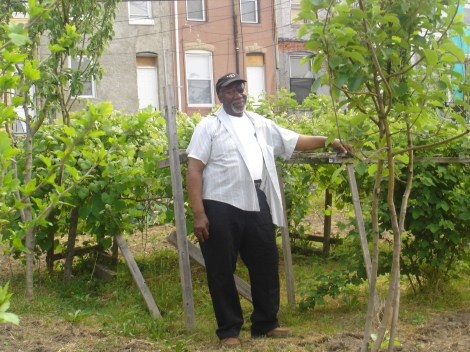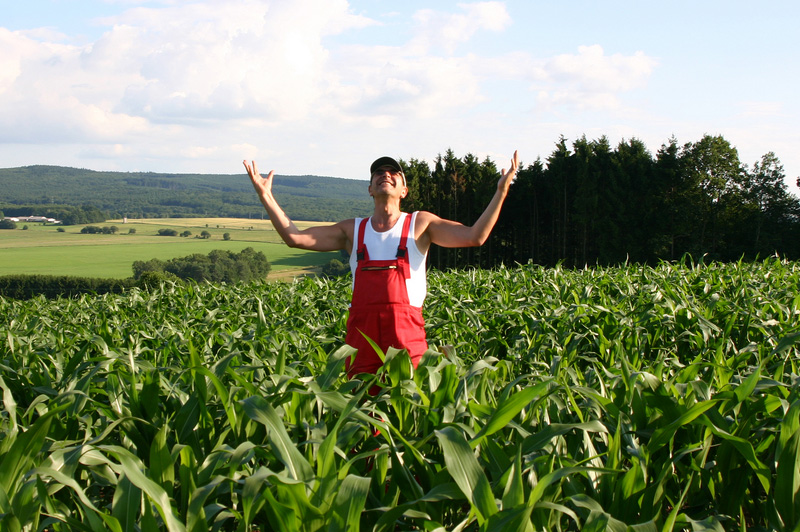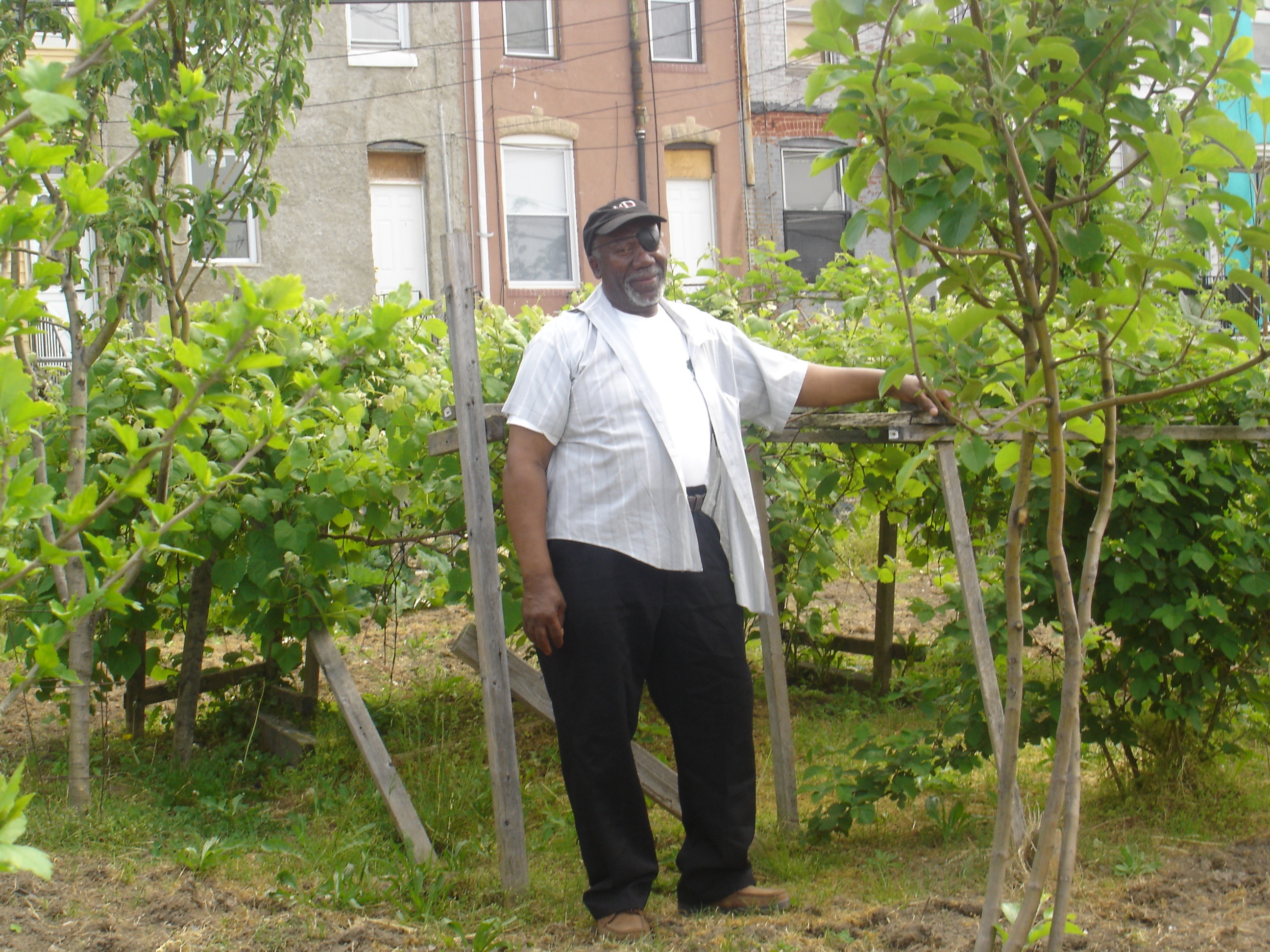
Anita Stewart-Hammerer
Fueled by the recent fascination with all things DIY, community gardening — like brainstorming clever uses for Mason jars and eating like a caveman — has been popular lately. But on a large plot in inner-city Baltimore, gardeners have been working the land for almost 25 years. The Duncan Street Miracle Garden, a lush rectangle crisscrossed by grape arbors and trellises, sits in a desolate patch of East Baltimore where 44 rowhouses once stood. On a recent spring day, the blue sky was visible through the empty shells of neighboring buildings and birdsong competed with police sirens.
“I call it ‘God’s little acre,'” says garden manager Lewis Sharpe, 74. The garden is in fact nearly an acre, and it owes its existence to a core group of dedicated gardeners. In 1988, with Baltimore in the throes of the crack cocaine epidemic, a local men’s group cleaned up what had become a dumping ground after the city razed a stretch of crumbling rowhouses. The gardeners then convinced the city to close the alley to traffic. Decades later, it is dotted with trees, including a mulberry that Sharpe likes to nap under, and row upon row of flower, fruit, and vegetable plants.
A few — the “fruit cocktail tree” and the “strawberry tree” — do sound vaguely miraculous. But the biggest miracle is that the garden is here at all.
A chain-link fence surrounds the plot, though it does nothing to thwart the rats, the garden’s worst pests. Instead, it was built some years back to deter a two-legged nuisance: drug dealers. “At one time they was running through here with police chasing ’em,” Sharpe says. “Now they ain’t got time to go over the fence. They go around it.”
Sharpe joined the farm in 1989, and as founding members passed away or began to garden less, he became its self-appointed manager. He — like famous Milwaukee urban farmer Will Allen — grew up on a farm, in his case in rural Virginia. “During the summer, grandma got us up at 6 a.m. and gave us a hoe or a shovel,” Sharpe says. “We’d go out there and cut the rows, put the seed, put fertilizer down.”
Health problems have kept him from retiring to his ancestral home, so Sharpe has done the next best thing: create an urban facsimile. “It keeps me busy,” he says simply.
In Baltimore, at least, his work fills a unique niche. Sharpe and his fellow green thumbs — there are about 10 — grow much more food than they can eat, so roughly half of the produce goes to local soup kitchens and neighborhood residents. (Sharpe also plants string beans outside the fence for passersby to snack on.) Moveable Feast, a local organization that helps homebound HIV/AIDS patients, has a plot here, as does a neighborhood Baptist church.
Buy-in from organizations like these will likely help the garden to survive in the future, as will participation by younger generations. Anita Stewart-Hammerer’s children have been gardening at Duncan Street for five years, since they were 5 and 8 years old, respectively. “I met Mr. Sharpe at the garden and we hit it off,” Stewart-Hammerer says. She worked in community development for a local organization at the time. “He said to me, ‘I’m gonna make a farmer out of you.'” Stewart-Hammerer is now Sharpe’s right-hand woman, responsible for the paperwork — applying for grants, soliciting donations — that keeps the gardeners in mulch, tools, seed, and plants. (It costs all of $20 to rent a plot for a year.)
Devoted gardeners and some nonprofit support have sustained Duncan Street over the years, but until recently it was living on borrowed time: There was nothing stopping the city from selling the land and evicting the gardeners. Then, in 2010, Baltimore Green Space, a local land trust, purchased the garden from the city for $1 per lot. The trust — which owns three other spaces, including a horseshoe pit — protects the garden from the vagaries of absentee landlords, developers, and the city, if not the ills of the neighborhood.
Land insecurity is a perennial (ahem) problem for urban gardeners. In 2006, after more than a decade, one of the largest urban farms in the country, South Central Farm in industrial Los Angeles, was bulldozed by a developer who wanted to build a warehouse there. Sharpe gazes out over the many species he favors that take years to produce: figs, asparagus, apples, grapes. “We don’t have to worry about that anymore,” he says.
“It’s a much easier sell to a city to say ‘It’s a win-win, just give it to us for a dollar,'” says Baltimore Green Space founder and Executive Director Miriam Avins. “Instead of looking at, you’re not going to be getting taxes from this piece of land, think about how it improves property values around it.”
That could be one of the ironies here: Some research has shown that community gardens improve property values [PDF] and lower crime rates, which could, paradoxically, lead to development.
The land trust will be there to protect the garden should that happen, however, and it seems like a distant threat in this stretch of East Baltimore. In any case, Avins says, community gardens like Duncan Street often serve as an organic (a-a-ahem) remedy for a problem that should never have existed. “A lot of our neighborhoods don’t have green space,” she says. “It’s kind of like people are retrofitting their neighborhoods with what should have been there.”
Though there’s always plenty of work to do at Duncan Street, that hasn’t stopped Lewis Sharpe from hatching grander plans. He has adopted at least a dozen neighboring lots from the city — under the program, residents steward a piece of land for a limited time — in order to make sure the grass is mowed and litter picked up. And he’s gardening another swath of vacant land that borders Duncan Street. As he says of his love for watermelons, “I don’t like a little bit of something. I like a lot.”



